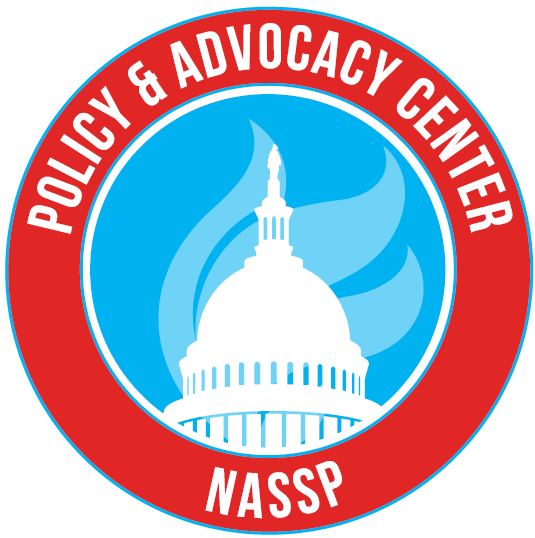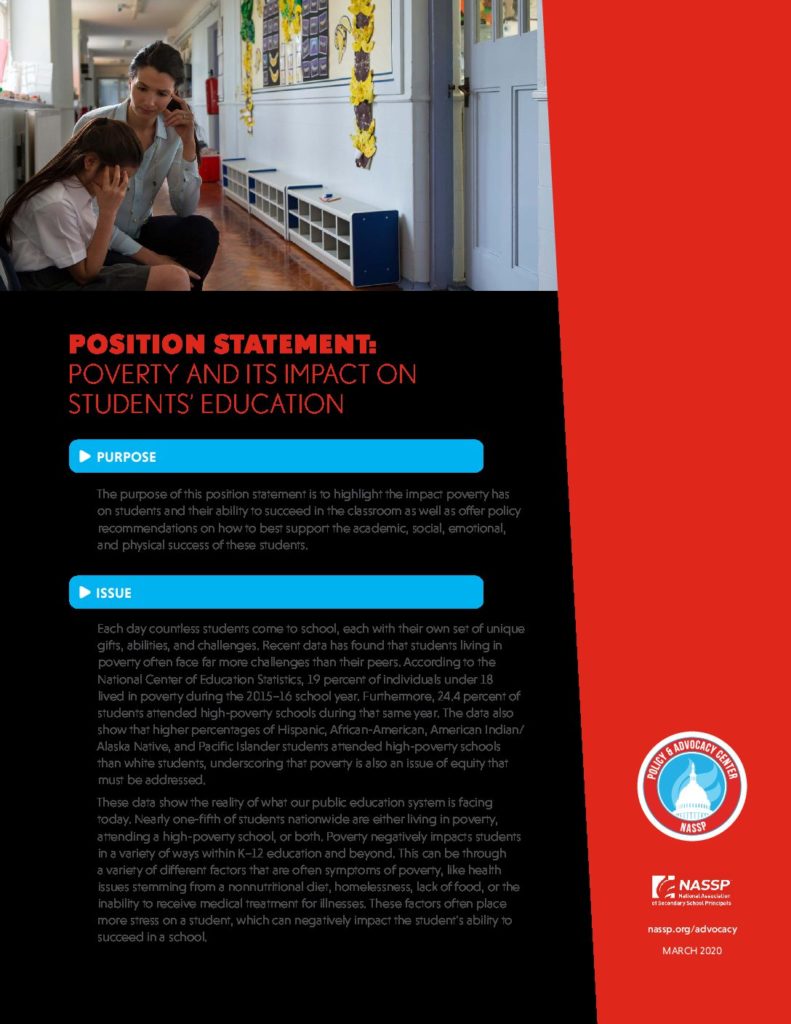The purpose of this position statement is to highlight the impact poverty has on students and their ability to succeed in the classroom as well as offer policy recommendations on how to best support the academic, social, emotional, and physical success of these students.
Each day countless students come to school, each with their own set of unique gifts, abilities, and challenges. Recent data has found that students living in poverty often face far more challenges than their peers. According to the National Center of Education Statistics, 19 percent of individuals under 18 lived in poverty during the 2015–16 school year. Furthermore, 24.4 percent of students attended high-poverty schools during that same year. The data also show that higher percentages of Hispanic, African-American, American Indian/Alaska Native, and Pacific Islander students attended high-poverty schools than white students, underscoring that poverty is also an issue of equity that must be addressed.

These data show the reality of what our public education system is facing today. Nearly one-fifth of students nationwide are either living in poverty, attending a high-poverty school, or both. Poverty negatively impacts students in a variety of ways within K–12 education and beyond. This can be through a variety of different factors that are often symptoms of poverty, like health issues stemming from a nonnutritional diet, homelessness, lack of food, or the inability to receive medical treatment for illnesses. These factors often place more stress on a student, which can negatively impact the student’s ability to succeed in a school.
Students living in poverty often have fewer resources at home to complete homework, study, or engage in activities that helps equip them for success during the school day. Many impoverished families lack access to computers, high-speed internet (three-fourths of households currently have access to high-speed broadband), and other materials that can aid a student outside of school. Parents of these families often work longer hours or multiple jobs, meaning they may not be available to assist their children with their schoolwork.
Furthermore, in many high-poverty school districts, resources are sorely lacking in schools. Nearly every state has its own division of funding for school districts and education based on property taxes. Unfortunately, this system unfairly affects individuals living in poverty and the students attending school in those areas. Because property taxes are often much lower in high-poverty areas, schools in those areas receive much less than their more affluently-located counterparts. Recent data from the U.S. Department of Education state that 40 percent of high-poverty schools are not getting a fair share of state and local funds. This often leaves schools with limited budgets to address a multitude of issues, including hiring educators, updating resources for students, preparing students for postsecondary education or the workforce, dealing with unsafe infrastructure, and much more. There are often instructional gaps for those attending high-poverty schools as well. Data from the 2015–16 National Teacher and Principal Survey show that students from low-income families “are consistently, albeit modestly, more likely to be taught by lower-credentialed and novice teachers” (Garcia and Weiss). Research has also shown that many teachers in high-poverty schools are inexperienced and often less effective than their more experienced peers who are often targeted for hire by higher-income schools and districts. The lack of high-quality instruction serves to only further separate academic achievement levels for students in high-poverty schools from peers in high-income schools or districts.
Guiding Principles
- All students, regardless of income level or background, are capable of and should receive the support and resources necessary for success.
- Students from low-income families often face additional barriers that can impede academic success compared to their peers from higher-income households.
- Principals provide leadership for instilling a culture of success and support within their school and should strive to provide each student with the supports necessary to achieve this success. Principals should strive to achieve this through all available avenues, including through strategic partnerships.
- The 2015 Professional Standards for Educational Leaders state that effective educational leaders strive for equity of educational opportunity and culturally responsive practices to promote each student’s academic success and well-being.
- NASSP has previously adopted position statements on the achievement gap and preparing all students for postsecondary success that offer policy recommendations to promote equitable support for all students and adequate preparation to enter the workforce or a postsecondary institution following high school.
- NASSP developed the Building Ranks™ framework to reflect the principal’s responsibility for building culture and leading learning to foster lifelong success for each child in a rapidly changing world.
Recommendations
Recommendations for Federal Policymakers
- Advance policies that incentivize and support well-trained teachers, principals, and other educators to work and remain in high-poverty schools.
- Provide additional federal funds and resources for programs, such as Title I and the Supplemental Nutrition Assistance Program, aimed at supporting students from low-income families.
- Ensure federal funds are divided equitably so that high-poverty districts are guaranteed a fairer share of federal dollars.
- Invest in school leadership required to hire and retain well-trained school leaders, recognizing the critical role principals play in establishing a culture and learning environment that students need to be successful in a global society.
- Prioritize school improvement strategies—such as community schools—that include resources and supports to address the barriers poverty creates to student success.
- Provide additional resources and invest in programs for students from low-income families to enter postsecondary education or the workforce.
- Enact legislation aimed at improving school infrastructure, with a particular focus on buildings in high-poverty districts that pose potential health threats to students, educators, and other faculty in the school.
- Expand the maximum allowance of Pell Grants, and share information with states, local education agencies, and universities on application eligibility and processes.
- Fully fund federal programs that increase connectivity for all students, like the E-Rate Program which provides discounted telecommunications services to schools.
Recommendations for State Policymakers
- Ensure state funding formulas are properly balanced so all districts receive an equitable and sufficient share of funds based on student poverty levels, property tax revenue per district, or other evidence-based indicators of poverty.
- Reevaluate state investments in education to ensure school districts are receiving the funds necessary to promote student success.
- Prioritize school improvement strategies—such as community schools—that include resources and supports to address the barriers to student success that poverty creates.
- Invest in curriculum that prepares students for 21st-century employment and participation in a democracy. This will prepare students for life beyond secondary education and better enable them to be successful in the workforce and financially secure.
- Prioritize and invest in state financial aid for school districts based on need instead of merit, which disproportionately helps high-income and white students.
- Make investments over a long-term basis rather than short term, as long-term investments have a proven track record of improving high-poverty school districts.
Recommendations for District Leaders
- Make sure that your district and school funding systems ensure equal access to core educational services for each student in K–12 education.
- Ensure that school funding systems provide additional resources for low-income students to ensure they have a more level playing field for achieving success.
- Use per-pupil expenditure (PPE) data to evaluate district funding decisions and make changes based on this data when inequities are presented.
- Support ongoing learning for school leaders, recognizing that their role is changing and that the demands of a high-poverty schools are expanding, requiring continual development.
- Advance policies that ensure highly-qualified educators are working in high-poverty schools.
- Urge state policymakers to reevaluate unfair funding practices that negatively impact high-poverty districts.
Recommendations for School Leaders
- Instill a culture of growth and success in your school that effectively educates all students about the opportunities available to them following secondary education.
- Provide benefits and resources within schools to all students so those living in poverty have the necessary supports to succeed, with the assistance of outside partners such as internet providers, food suppliers, or healthcare organizations. Examples include: free breakfast, extended library or lab hours after school, allowing students to take home wifi hotspots, etc.
- Provide professional development for teachers and staff to assist them in working effectively with students in poverty and address the impact of associated trauma and chronic stress.
- Provide students with access to college admissions, scholarships, financial aid information, and personnel to help students with these discussions so students are properly educated on postsecondary education opportunities.
- Ensure that budget discussions and requests are conducted in a transparent process that allows for input from a variets of groups and stakeholders in the school community.
Resources
Amerikaner, A., & Morgan, I. (2018, February 27). Funding gaps 2018: An analysis of school funding equity across the U.S. and within each state. Retrieved from https://edtrust.org/resource/funding-gaps-2018/.
Carey, K., & Harris, E. (2016). It turns out spending more probably does improve education. Retrieved from https://www.nytimes.com/2016/12/12/nyregion/it-turns-out-spending-more-probably-does-improve-education.html?_r=0.
Carr, S. (2013, February 26). The real reasons many low-income students don’t go to college. Retrieved from https://hechingerreport.org/the-real-reasons-many-low-income-students-dont-go-to-college/.
College for America. (2017, June 7). Addressing the college completion gap among low-income students. Retrieved from https://collegeforamerica.org/college-completion-low-income-students/.
Dynarski, M. (2017, March 1). It’s not nothing: The role of money in improving education. Retrieved from https://www.brookings.edu/research/its-not-nothing-the-role-of-money-in-improving-education/.
Garcia, E., & Weiss, E. (2019, March 26). The teacher shortage is real, large and growing, and worse than we thought: The first report in ‘The Perfect Storm in the Teacher Labor Market’ series. Retrieved from https://www.epi.org/publication/the-teacher-shortage-is-real-large-and-growing-and-worse-than-we-thought-the-first-report-in-the-perfect-storm-in-the-teacher-labor-market-series/.
Jensen, E. (2013, May). How poverty affects classroom engagement. ASCD. Retrieved from http://www.ascd.org/publications/educational-leadership/may13/vol70/num08/How-Poverty-Affects-Classroom-Engagement.aspx.
Johnston, K. (2019, June 20). 7 ways poverty affects education. Retrieved from https://moneywise.com/a/ways-poverty-affects-education.
Jackson, K., Johnson, R., & Persico, C. (2016). The effects of school spending on education and economic outcomes: Evidence from school finance reforms. The Quarterly Journal of Economics 131(1), pp. 157–218.
LaFortune, J., Rothstein, J., & Schanzenbach, D.W. (2016). School Finance Reform and the Distribution of Student Achievement. National Bureau of Economic Research, Working Paper 22011, February 2016.
Martin, C., Boser, U., Benner, M., & Baffour, P. (2018, November 13). A quality approach to school funding. Center for American Progress. Retrieved from https://www.americanprogress.org/issues/education-k-12/reports/2018/11/13/460397/quality-approach-school-funding/
McFarland, J., Hussar, B., Wang, X., Zhang, J., Wang, K., Rathbun, A., Barmer, A., Forrest Cataldi, E., and Bullock Mann, F. (2018). The Condition of Education 2018 (NCES 2018-144). U.S. Department of Education. Washington, DC: National Center for Education Statistics. Retrieved from https://nces.ed.gov/pubs2018/2018144.pdf.
National Association of Secondary School Principals. (2019, March 19). Using PPE data to advocate for your school. School of Thought blog. Retrieved from http://blog.nassp.org/2019/03/22/using-ppe-data-to-advocate-for-your-school/.
Parrett, W., & Budge, K. (2016, January 13). How does poverty influence learning? Retrieved from https://www.edutopia.org/blog/how-does-poverty-influence-learning-william-parrett-kathleen-budge.
Pascoe, M.C., Hetrick, S.E. & Parker., A.G. (2019). The impact of stress on students in secondary school and higher education. International Journal of Adolescence and Youth, DOI: 10.1080/02673843.2019.1596823.
Taylor, K. (2019, July 25). Poverty’s long-lasting effects on students’ education and success. Retrieved from https://www.insightintodiversity.com/povertys-long-lasting-effects-on-students-education-and-success/.
Turner, C., Khrais, R., Lloyd, T., Olgin, A., Isensee, L., Vevea, B., & Carsen, D. (2016, April 18). Why America’s schools have a money problem. Retrieved from https://www.npr.org/2016/04/18/474256366/why-americas-schools-have-a-money-problem.

